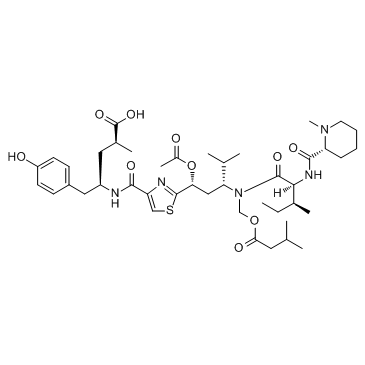ADC Cytotoxin
ADC Cytotoxin are a large collection of toxins for antibody-drug conjugate (ADC) development projects. The toxins that can be used as payloads should be soluble, amenable to conjugation, and stable. There are myriads of cellular toxins in natural or synthesized, but only a few have been found adaptable for an ADC concept.
The toxins targeting tubulin filaments include Maytansinoids, Auristatins, Taxol derivatives, etc. Amatoxins are a class of transcription-inhibiting agents. They bind to RNA polymerase II, leading to cell apoptosis. Protein toxins function in the similar MOA (mechanism of action) with cellular toxins, they could inhibit protein synthesis and induce cell death. While enzyme-based ADCs alter the microenvironment of disease tissues to disturb their functions.
Ziele für ADC Cytotoxin
Produkte für ADC Cytotoxin
- Bestell-Nr. Artikelname Informationen
-
GC34955
(+)-CBI-CDPI1
(+)-CBI-CDPI1 ist ein erweitertes funktionelles Analogon von CC-1065. (+)-CBI-CDPI1 ist ein DNA-Alkylierungsmittel. (+)-CBI-CDPI1 ist ein AntikÖrper-Wirkstoff-Konjugat (ADCs)-Toxin.
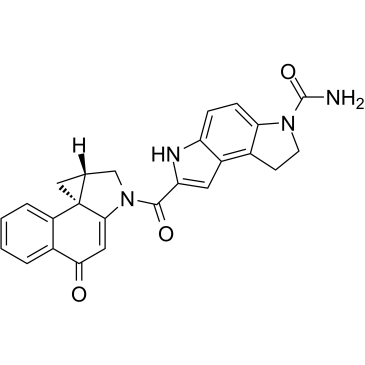
-
GC34956
(+)-CBI-CDPI2
(+)-CBI-CDPI2 ist ein erweitertes funktionelles Analogon von CC-1065. (+)-CBI-CDPI1 ist ein DNA-Alkylierungsmittel. (+)-CBI-CDPI2 ist ein AntikÖrper-Wirkstoff-Konjugat (ADCs)-Toxin.
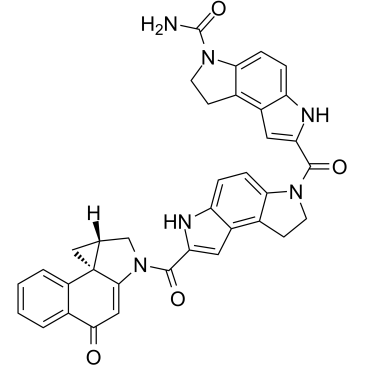
-
GC60421
(S)-Seco-Duocarmycin SA
(S)-Seco-Duocarmycin SA ist ein DNA-Alkylator, zytotoxisch fÜr Krebszellen und wirkt als ADC-Zytotoxin fÜr AntikÖrper-Wirkstoff-Konjugate.
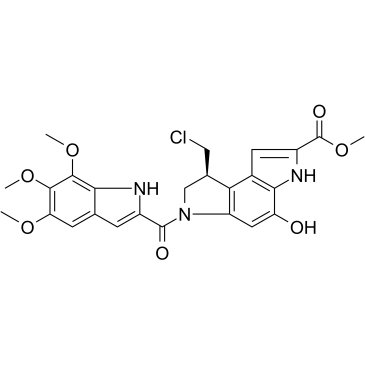
-
GC35044
10-Deacetyl-7-xylosyl paclitaxel
10-Deacetyl-7-xylosyl-Paclitaxel ist ein Paclitaxel-Derivat (ein Mikrotubulus-Stabilisierungsmittel; verstÄrkt die Tubulin-Polymerisation) mit verbesserten pharmakologischen Eigenschaften.
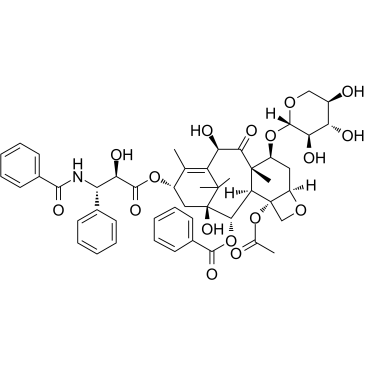
-
GC14858
Aldoxorubicin
Aldoxorubicin (INNO-206) ist ein albuminbindendes Prodrug von Doxorubicin (DNA-Topoisomerase-II-Inhibitor), das unter sauren Bedingungen aus Albumin freigesetzt wird. Aldoxorubicin (INNO-206) hat starke AntitumoraktivitÄten in verschiedenen Krebszelllinien und in murinen Tumormodellen.
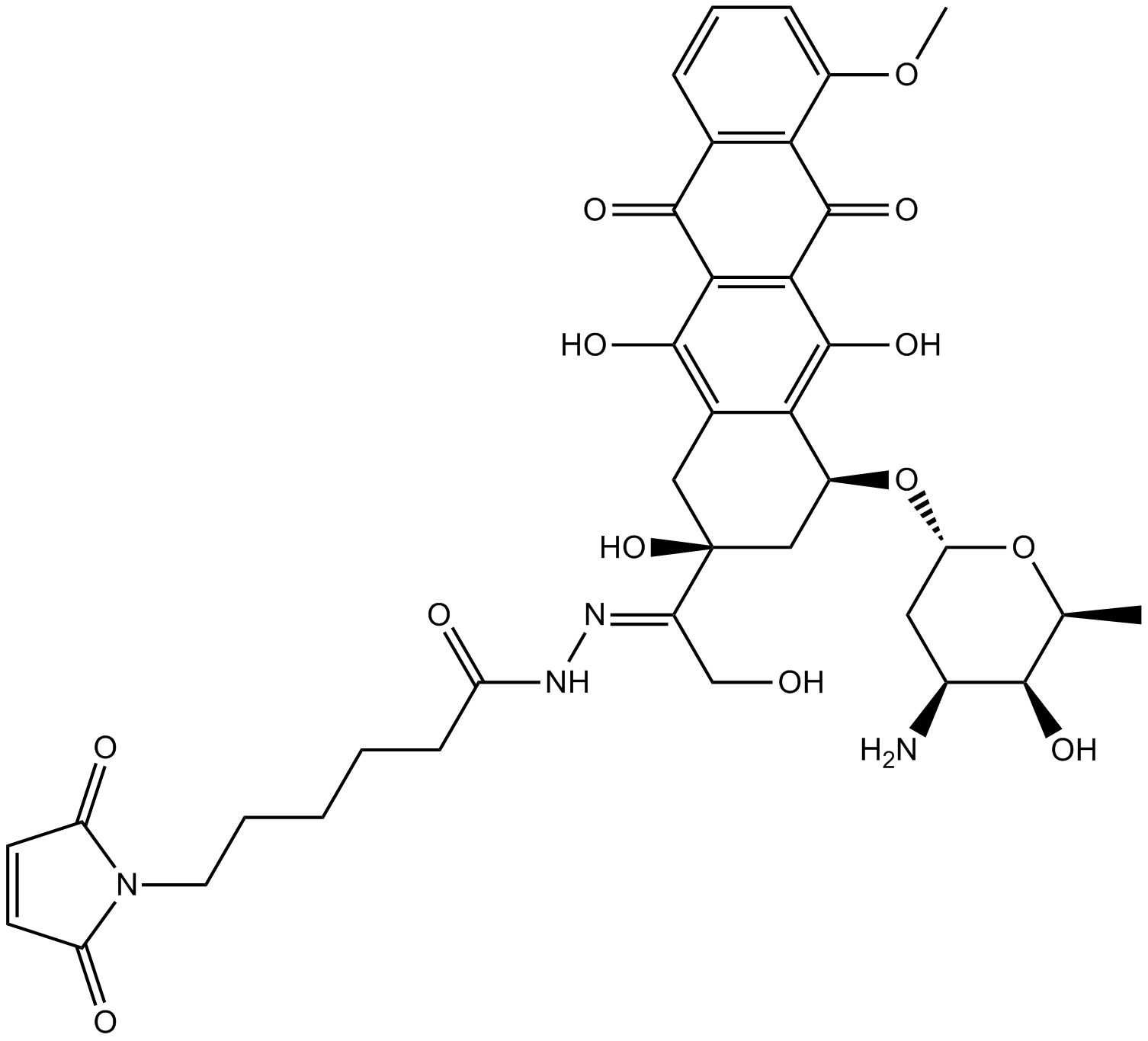
-
GC61563
Aminohexylgeldanamycin
Aminohexylgeldanamycin (AHGDM), ein Geldanamycin-Derivat, ist ein potenter HSP90-Inhibitor. Aminohexylgeldanamycin zeigt antiangiogene und AntitumoraktivitÄten.
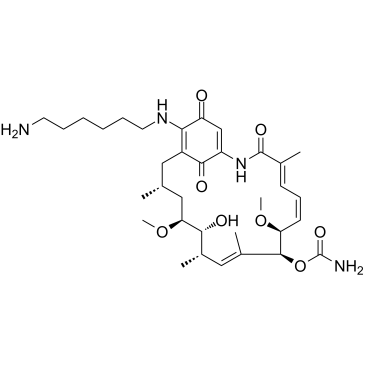
-
GC11947
Ansamitocin P-3
A microtubule depolymerizing agent
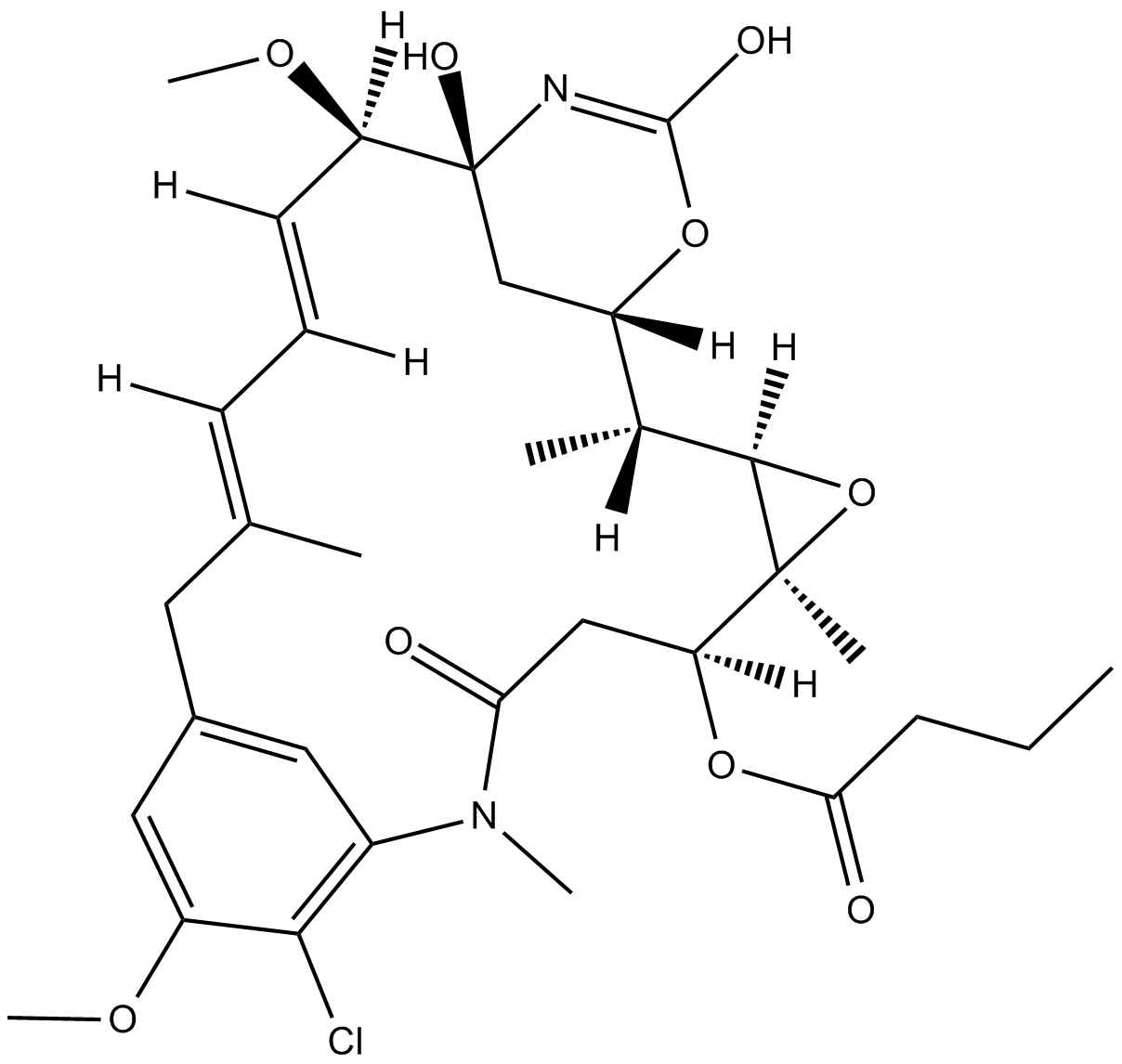
-
GC35429
Auristatin E
Auristatin E ist ein zytotoxischer Tubulin-Modifikator mit starker und selektiver AntitumoraktivitÄt; MMAE-Analogon und Zytotoxin in AntikÖrper-Wirkstoff-Konjugaten. Auristatin E hemmt die Zellteilung, indem es die Polymerisation von Tubulin blockiert.
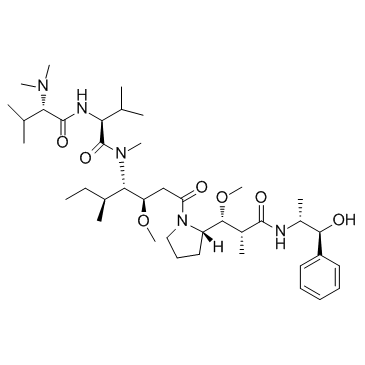
-
GC35430
Auristatin F
Auristatin F ist ein starkes Zytotoxin. Auristatin F, ein potenter Mikrotubuli-Inhibitor und gefÄßschÄdigender Wirkstoff (VDA), kann in AntikÖrper-Wirkstoff-Konjugaten (ADC) verwendet werden.
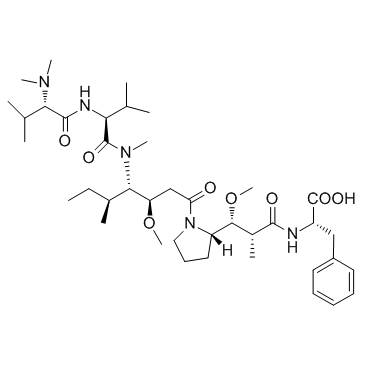
-
GC35574
C-11
C-11 ist ein Tubulin-Inhibitor und wirkt als ADC-Zytotoxin, zeigt ZytotoxizitÄt fÜr Karzinomzelllinien.
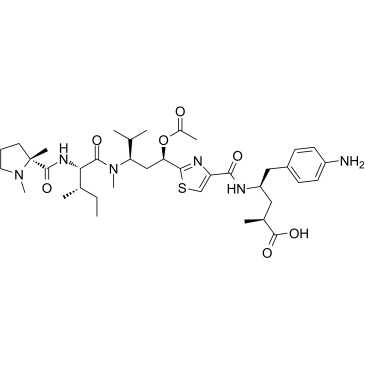
-
GC19086
Calicheamicin
Calicheamicin, ein Antitumor-Antibiotikum, ist ein zytotoxisches Mittel, das DNA-DoppelstrangbrÜche verursacht.
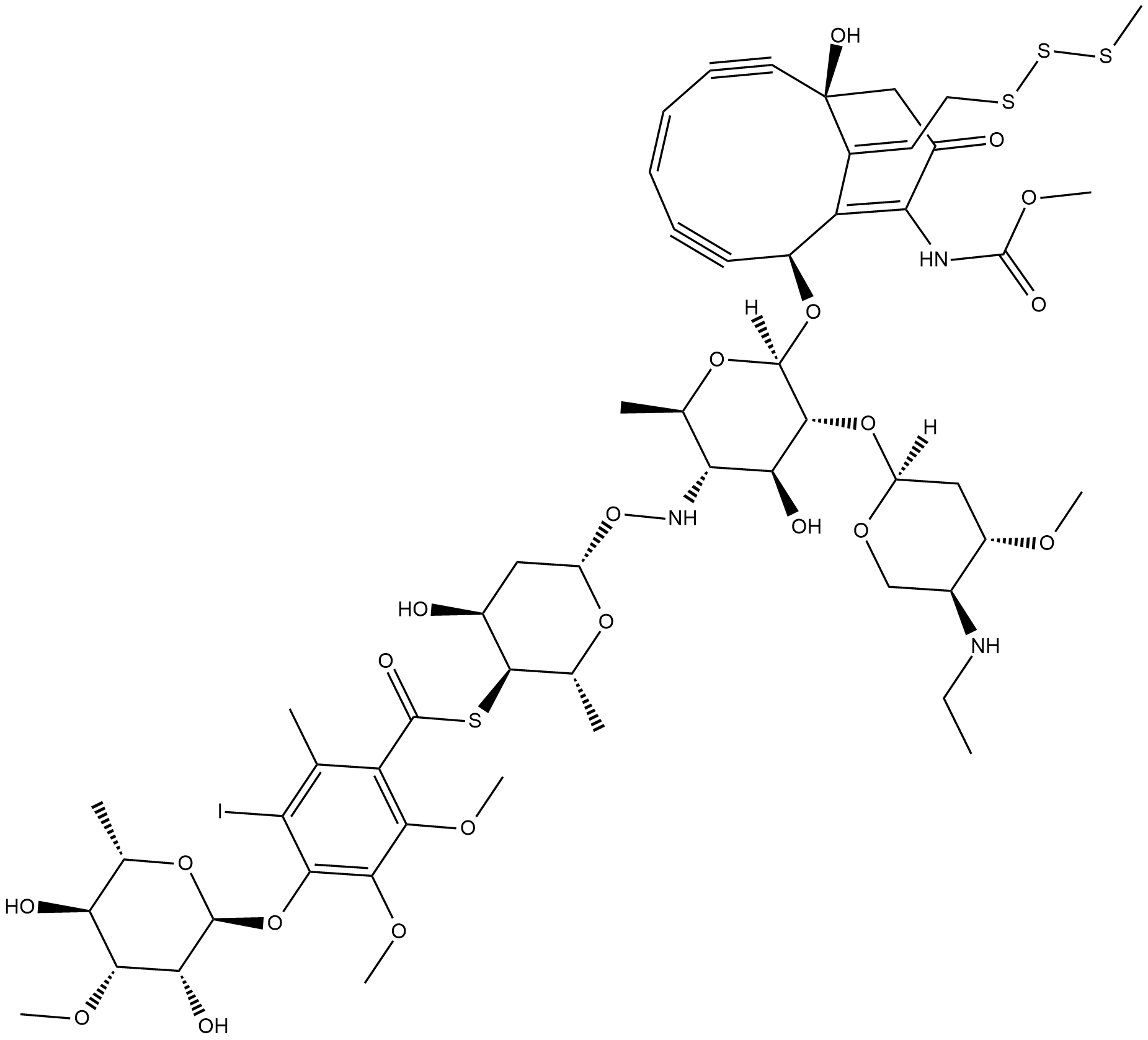
-
GC38016
Cyclooctyne-O-NHS ester
Cyclooctin-O-NHS-Ester ist ein spaltbarer ADC-Linker, der bei der Synthese von AntikÖrper-Wirkstoff-Konjugaten (ADCs) verwendet wird.
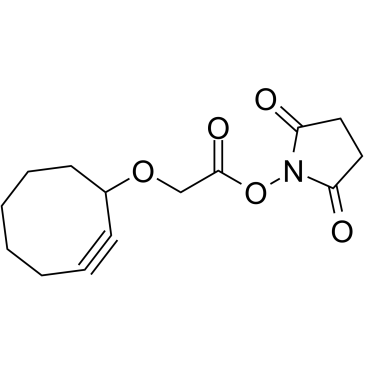
-
GC38631
Cyclooctyne-O-PFP ester
Cyclooctin-O-PFP-Ester ist ein spaltbarer ADC-Linker, der bei der Synthese von AntikÖrper-Wirkstoff-Konjugaten (ADCs) verwendet wird.
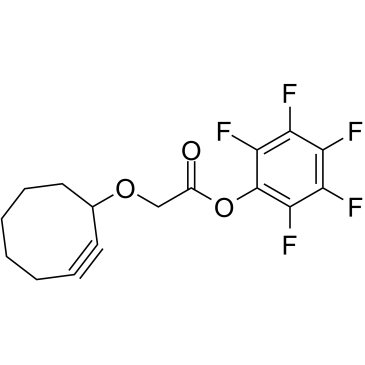
-
GC35797
D8-MMAD
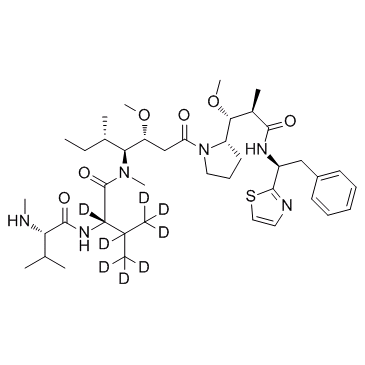
-
GC35798
D8-MMAF
D8-MMAF-Hydrochlorid ist eine deuterierte Form von MMAF-Hydrochlorid. MMAF-Hydrochlorid, ein potenter Tubulin-Polymerisationsinhibitor, wird als Antitumormittel und als zytotoxische Komponente von AntikÖrper-Wirkstoff-Konjugaten (ADCs) verwendet.
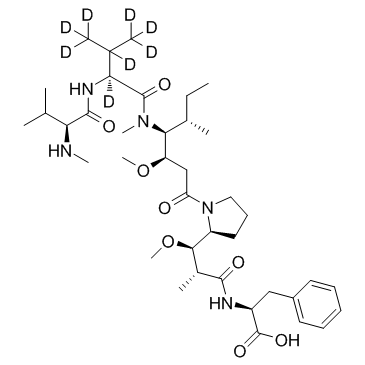
-
GC35799
D8-MMAF hydrochloride
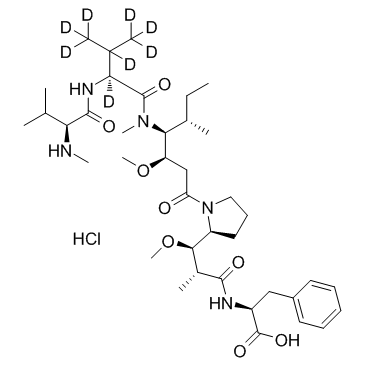
-
GC11175
Daun02
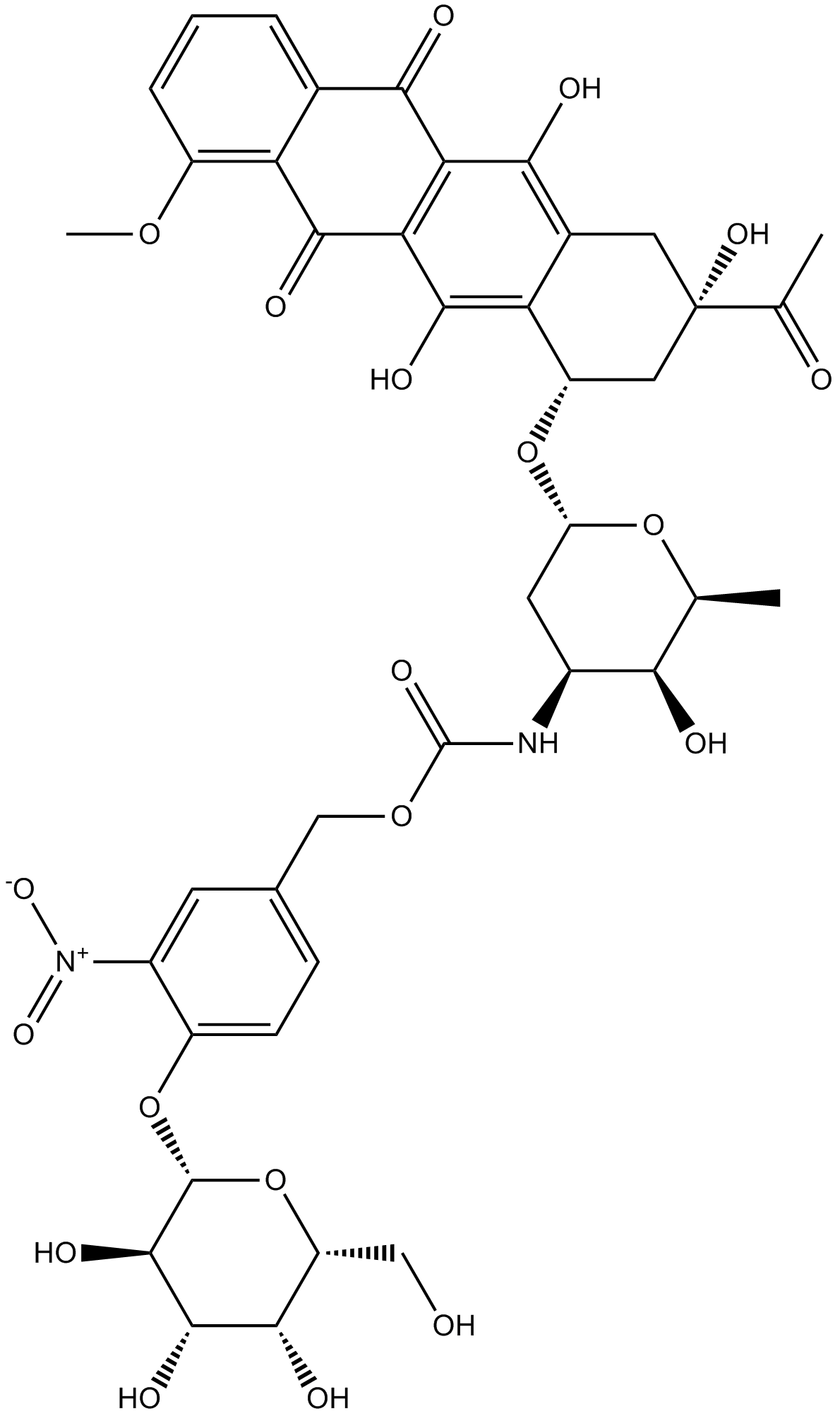
-
GC12828
Daunorubicin
DNA-Topoisomerase-II-Inhibitor
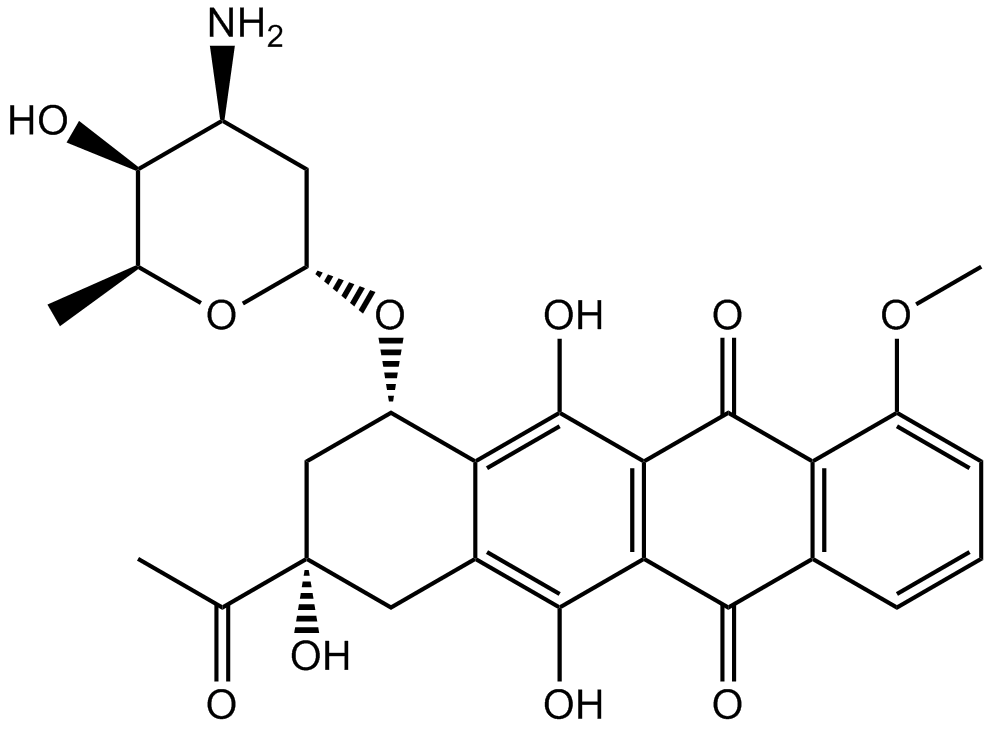
-
GC10354
Daunorubicin HCl
Daunorubicin (Daunomycin)-Hydrochlorid ist ein Topoisomerase-II-Inhibitor mit starker AntitumoraktivitÄt.
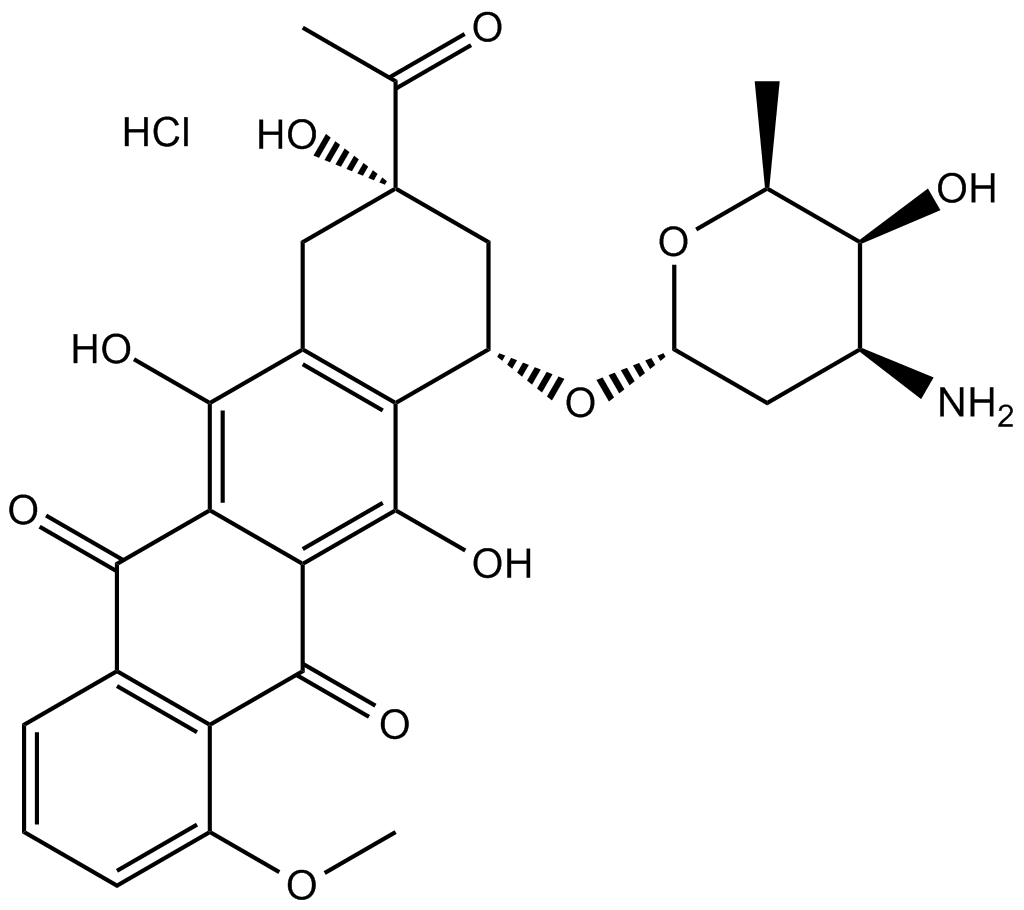
-
GC38538
DC0-NH2
DC0-NH2 ist eine Effektoreinheit fÜr ADC und ein vereinfachtes Analogon von DC1 mit besserer StabilitÄt. DC0-NH2 ist etwa 1000-mal zytotoxischer als hÄufig verwendete Krebsmedikamente (z. B. Doxorubicin). DC0-NH2 kann an die kleine Furche der DNA binden, gefolgt von der Alkylierung von Adeninresten durch seine Propabbenzindol (CBI)-Komponente.
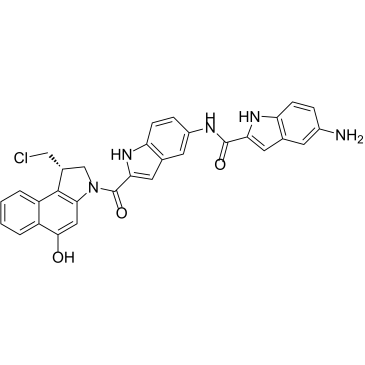
-
GC34185
DC1
DC1, ein Analogon des an die kleine Furche bindenden DNA-Alkylators CC-1065, ist ein ADC-Cytotoxin. DC1 kann bei der Synthese von AntikÖrper-Wirkstoff-Konjugaten zur gezielten Behandlung von Krebs verwendet werden.
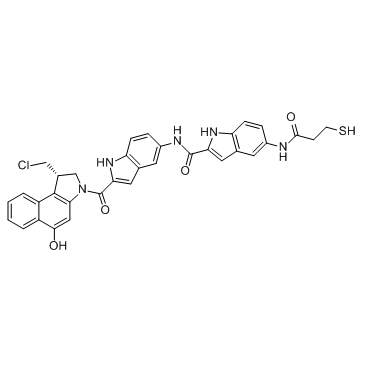
-
GC34190
DC1-SMe
DC1Sme, ein DC1-Derivat, zeigt IC50-Werte von 22 pM, 10 pM, 32 pM und 250 pM für Ramos-, Namalwa-, HL60/s- bzw. COLO 205-Krebszellen. DC1, ein Analogon des an die kleine Furche bindenden DNA-Alkylators CC-1065, ist ein ADC-Cytotoxin. DC1 kann bei der Synthese von Antikörper-Wirkstoff-Konjugaten zur gezielten Behandlung von Krebs verwendet werden.
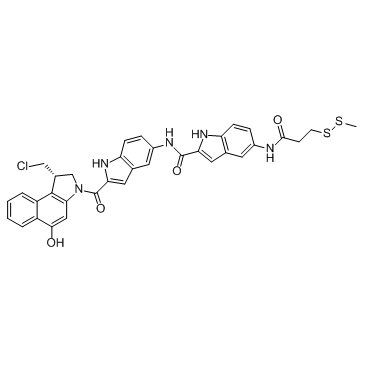
-
GC35817
DC41
DC41 ist ein DC1-Derivat. DC1, ein vereinfachtes Analogon von CC-1065, ist ein AntikÖrperkonjugat aus zytotoxischen DNA-Alkylatoren zur gezielten Behandlung von Krebs.
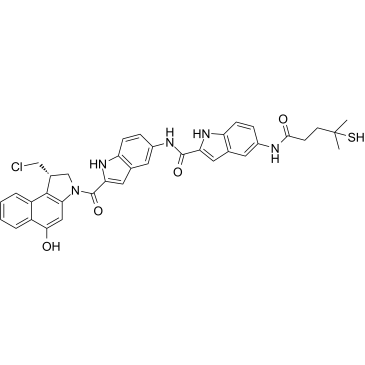
-
GC35818
DC41-SMe
DC41-SMe, ein DC1-Derivat, zeigt Zytotoxizität in Ramos-, Namalwa- und HL60/s-Zellen mit IC50-Werten im Bereich von 18–25 pM. DC1, ein vereinfachtes Analogon von CC-1065, ist ein Antikörperkonjugat aus zytotoxischen DNA-Alkylatoren zur gezielten Behandlung von Krebs.
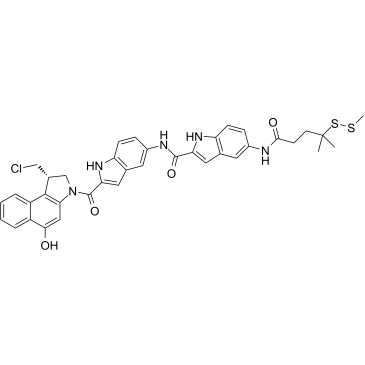
-
GC60143
DM3
DM3 (Maytansinoid DM3) ist ein Maytansin-Analogon, das Disulfid- oder Thiolgruppen und einen Tubulin-Inhibitor trÄgt, und ist eine zytotoxische Einheit von AntikÖrper-Wirkstoff-Konjugaten (ADCs).
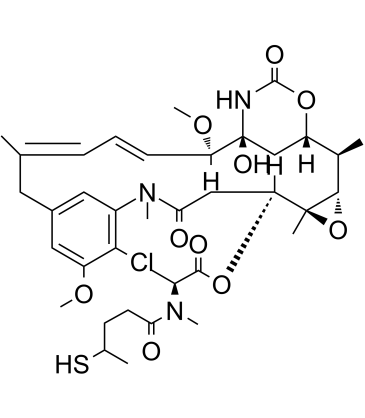
-
GC38355
DM3-SMe
DM3-SMe ist ein Maytansin-Derivat und ein Tubulin-Inhibitor und ist eine zytotoxische Einheit von AntikÖrper-Wirkstoff-Konjugaten (ADCs), die Über Disulfidbindungen oder stabile Thioetherbindungen an AntikÖrper gebunden werden kÖnnen. DM3-SMe zeigt in vitro eine stark zytotoxische AktivitÄt mit einem IC50 von 0,0011 nM.
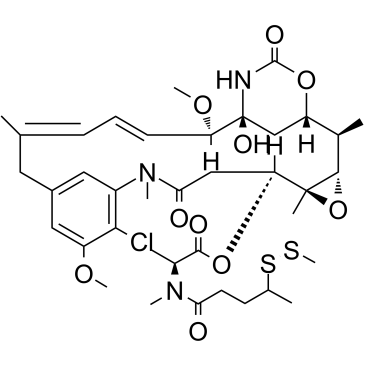
-
GC38468
DM4-SMe
DM4-SMe ist ein Metabolit von AntikÖrper-Maytansin-Konjugaten (AMCs) und ein Tubulin-Inhibitor sowie eine zytotoxische Einheit von AntikÖrper-Wirkstoff-Konjugaten (ADCs), die Über Disulfidbindungen oder stabile Thioetherbindungen an AntikÖrper gebunden werden kÖnnen. DM4-SMe hemmt KB-Zellen mit einem IC50 von 0,026 nM.
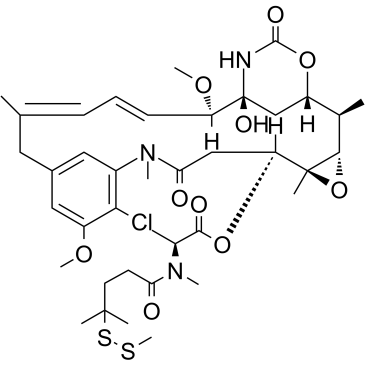
-
GC16273
Dolastatin 10
Dolastatin 10 (DLS 10) ist ein starkes antimitotisches Peptid, das die Tubulinpolymerisation hemmt.
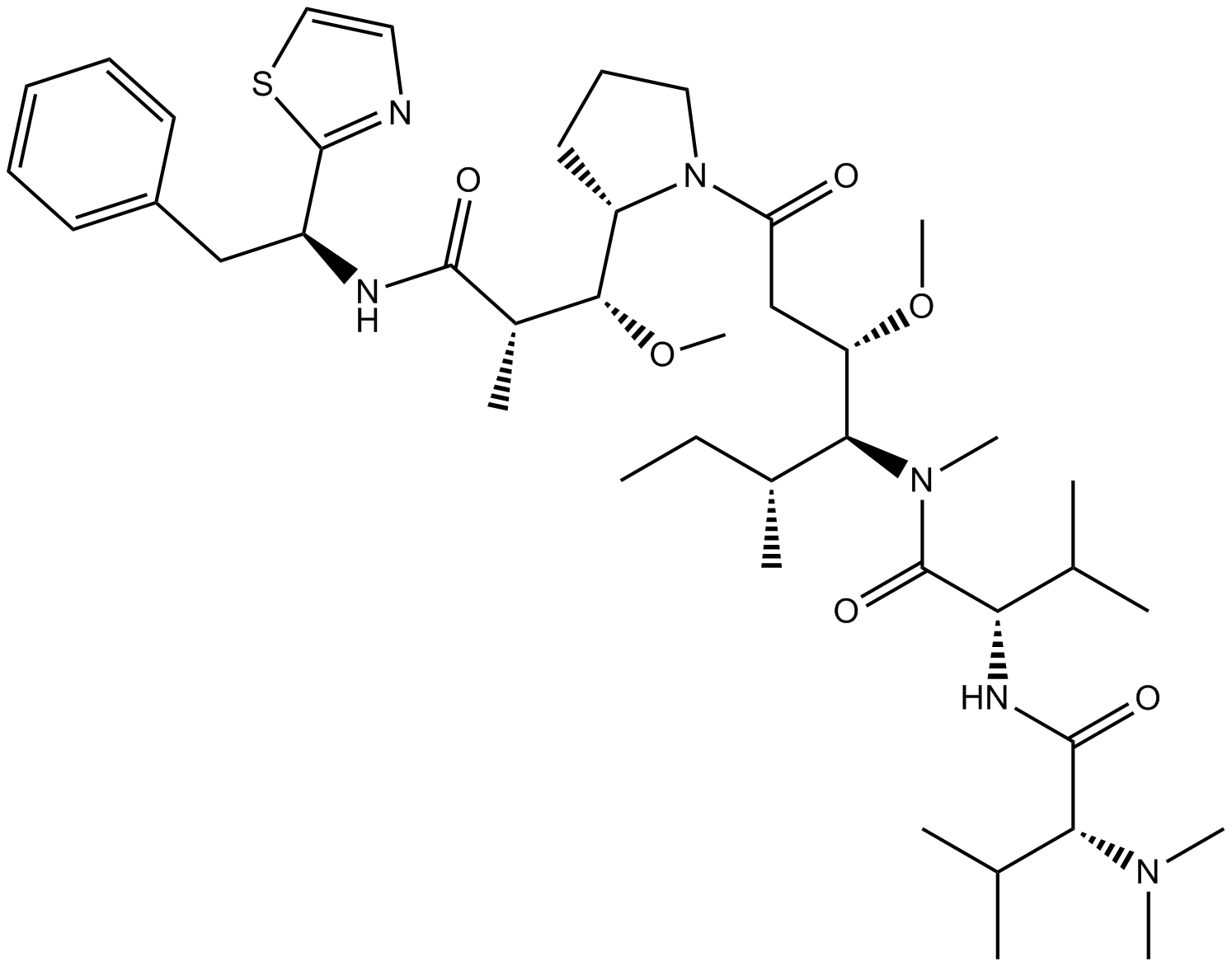
-
GA21397
Dolastatin 15
Dolastatin 15 (DLS 15), ein von Dolabella auricularia abgeleitetes Depsipeptid, ist ein starkes Antimitosemittel, das strukturell mit dem Antitubulinmittel Dolastatin 10 verwandt ist. Dolastatin 15 induziert Zellzyklusstillstand und Apoptose in multiplen Myelomzellen. Dolastatin 15 kann als ADC-Zytotoxin verwendet werden.

-
GC17567
Doxorubicin (Adriamycin) HCl
Doxorubicin (Hydroxydaunorubicin) Hydrochlorid, ein zytotoxisches Anthracyclin-Antibiotikum, ist ein Chemotherapeutikum zur Behandlung von Krebs.
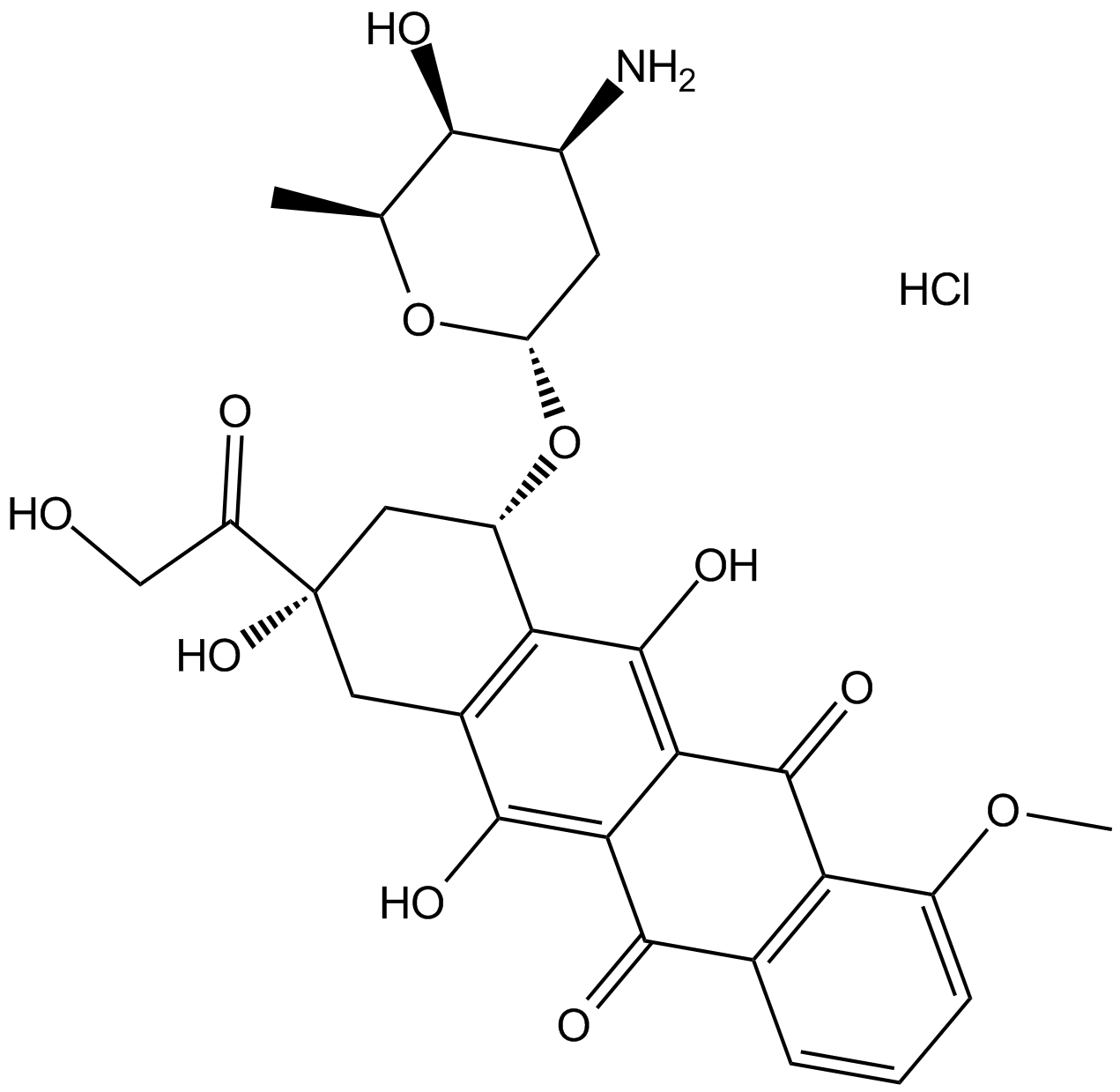
-
GC38774
DRF-1042
DRF-1042 ist ein oral aktives Derivat von Camptothecin. DRF-1042 hemmt die DNA-Topoisomerase I. DRF-1042 zeigt eine gute AntikrebsaktivitÄt gegen eine Reihe von menschlichen Krebszelllinien, einschließlich des Multi-Drug-Resistance (MDR)-PhÄnotyps.

-
GC35908
Duocarmycin A
Duocarmycin A, eines der bekannten Antitumor-Antibiotika, ist ein DNA-Alkylator und alkyliert effizient Adenin N3 am 3'-Ende von AT-reichen Sequenzen in der DNA. Duocarmycin A als Chemotherapeutikum fÜhrt bei HLC-2-Zellen typischerweise zu apoptotischen VerÄnderungen, einschließlich Chromatinkondensation, Sub-G1-Akkumulation im DNA-Histogrammmuster und Abnahme der Procaspase-3- und -9-Spiegel.
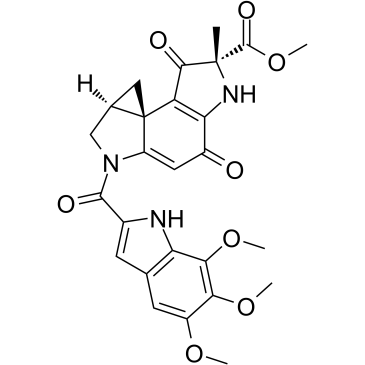
-
GC38080
Duocarmycin Analog
Duocarmycin Analog ist ein Analog von Duocarmycin und wird als DNA-Alkylator und ADC-Zytotoxin verwendet.
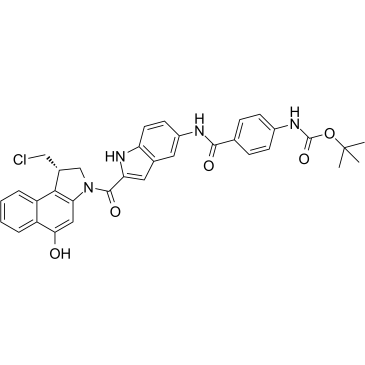
-
GC35909
Duocarmycin GA
Duocarmycin GA ist ein AntikÖrper-Wirkstoff-Konjugat (ADCs)-Toxin. Duocarmycin ist ein DNA-Alkylierungsmittel, das in der kleinen Furche bindet. Duocarmycin GA kann gegen multiresistente Zelllinien eingesetzt werden.
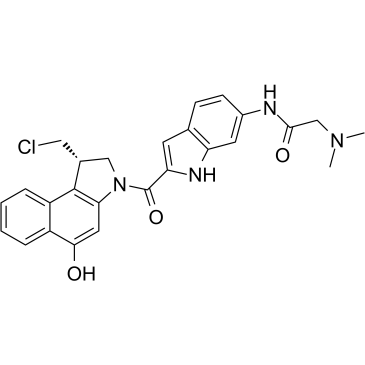
-
GC35910
Duocarmycin MA
Duocarmycin MA ist ein AntikÖrper-Wirkstoff-Konjugat (ADCs)-Toxin. Duocarmycin ist ein DNA-Alkylierungsmittel, das in der kleinen Furche bindet. Duocarmycin MA kann gegen multiresistente Zelllinien eingesetzt werden.
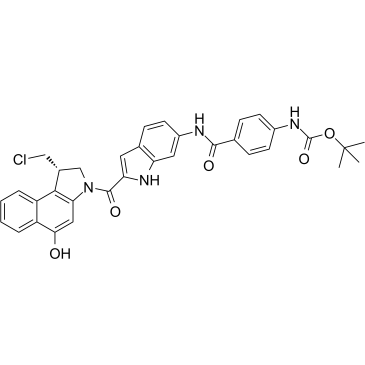
-
GC35911
Duocarmycin MB
Duocarmycin MB ist ein AntikÖrper-Wirkstoff-Konjugat (ADCs)-Toxin. Duocarmycin ist ein DNA-Alkylierungsmittel, das in der kleinen Furche bindet. Duocarmycin MB kann gegen multiresistente Zelllinien eingesetzt werden.
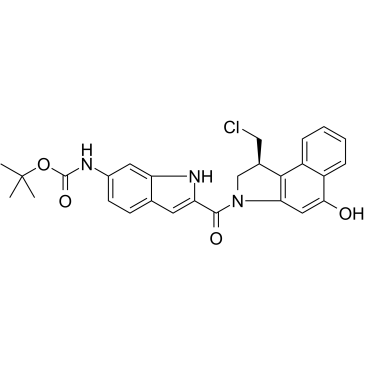
-
GC35912
Duocarmycin SA
Duocarmycin SA ist ein starkes Antitumor-Antibiotikum mit einer IC50 von 10 pM. Duocarmycin SA ist ein Äußerst wirksames zytotoxisches Mittel, das eine sequenzselektive Alkylierung von Duplex-DNA induzieren kann. Duocarmycin SA zeigt synergistische ZytotoxizitÄt gegen Glioblastoma multiforme (GBM)-Zellen, die in vitro mit Protonenbestrahlung behandelt wurden.
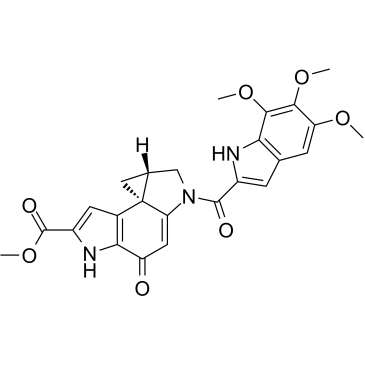
-
GC32187
Duocarmycin TM
Duocarmycin TM (CBI-TMI) ist ein wirksames antitumorales Antibiotikum. Duocarmycin TM führt zu einer sequenzselektiven Alkylierung von doppelsträngiger DNA.
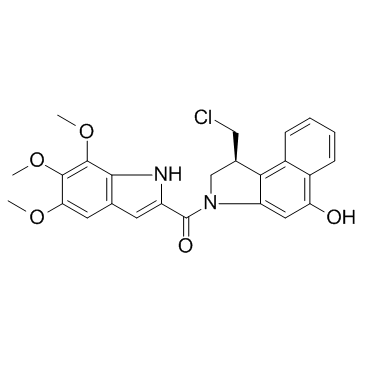
-
GC32926
Dxd (Exatecan derivative)
Dxd (Exatecan-Derivat) (Exatecan-Derivat fÜr ADC) ist ein potenter DNA-Topoisomerase-I-Inhibitor mit einem IC50-Wert von 0,31 μM, der als konjugiertes Medikament von HER2-gerichtetem ADC (DS-8201a) verwendet wird.
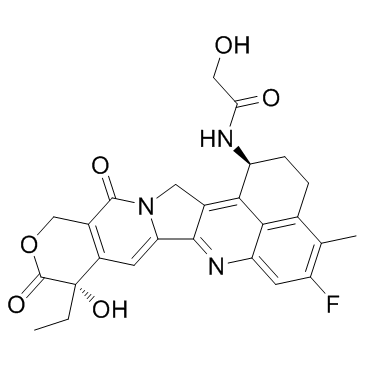
-
GC62212
Dxd-D5
Dxd-d5 (Exatecan-d5-Derivat fÜr ADC) ist ein Deuterium mit der Bezeichnung Dxd. Dxd ist ein potenter DNA-Topoisomerase-I-Inhibitor mit einem IC50 von 0,31 μM, der als konjugiertes Medikament von HER2-gerichtetem ADC (DS-8201a) verwendet wird.
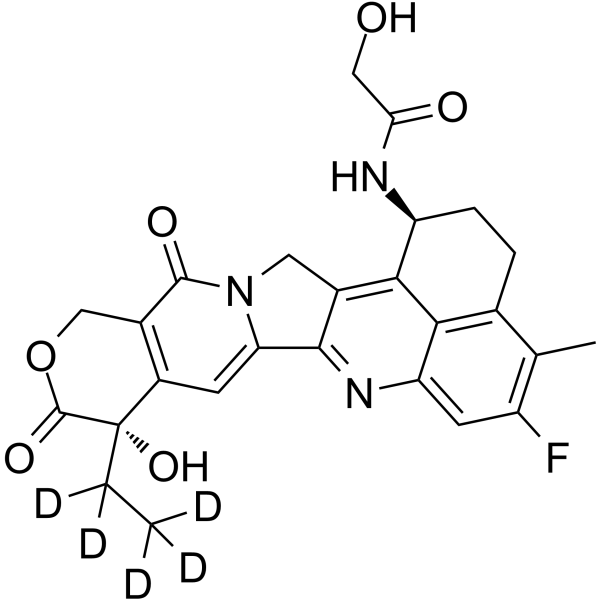
-
GC43882
Hygrolidin
Hygrolidin ist ein 16-gliedriges Makrolid-Antibiotikum, das von Streptomyces hygroscopicus D-1166 produziert wird.

-
GC32895
Maytansinol (Ansamitocin P-0)
Maytansinol (Ansamitocin P-0) hemmt die Mikrotubuli-Montage und induziert die Mikrotubuli-Demontage in vitro.
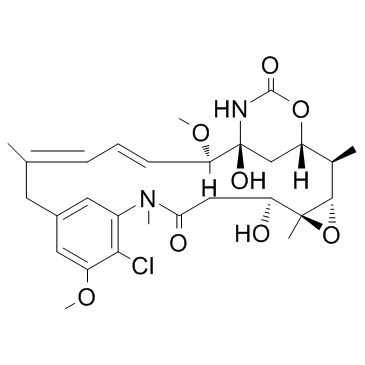
-
GC47620
Mensacarcin
Mensacarcin, ein hochkomplexes Polyketid, hemmt universell das Zellwachstum in Krebszelllinien stark und induziert wirksam Apoptose in Melanomzellen. Mensacarcin zielt auf Mitochondrien ab, beeinflusst den Energiestoffwechsel in Mitochondrien und aktiviert Caspase-abhÄngige apoptotische Signalwege. Mensacarcin, ein Antibiotikum, kann als zytotoxische Komponente von AntikÖrper-Wirkstoff-Konjugaten (ADCs) verwendet werden.

-
GC19244
Mertansine
Mertansin (DM1) ist ein Mikrotubulin-Inhibitor, der an den Spitzen von Mikrotubuli bindet und die Dynamik von Mikrotubuli unterdrückt.
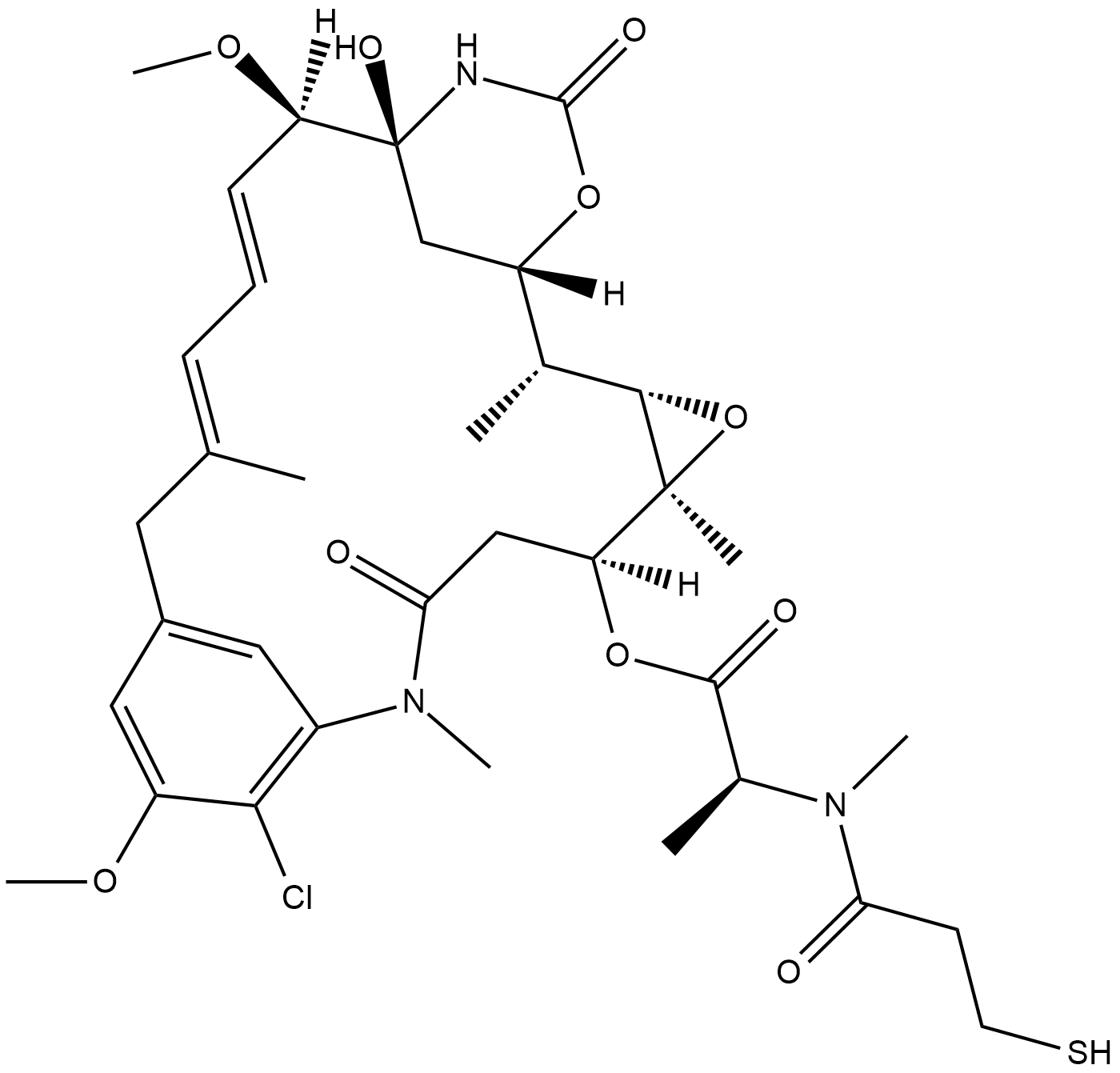
-
GC10405
Methotrexate
Methotrexat, ein Folsäureantagonist, ist ein wirksames entzündungshemmendes Mittel, wenn es wöchentlich in niedrigen Konzentrationen angewendet wird. Die antiphlogistische Wirkung beruht auf einer erhöhten Freisetzung von Adenosin an entzündeten Stellen.
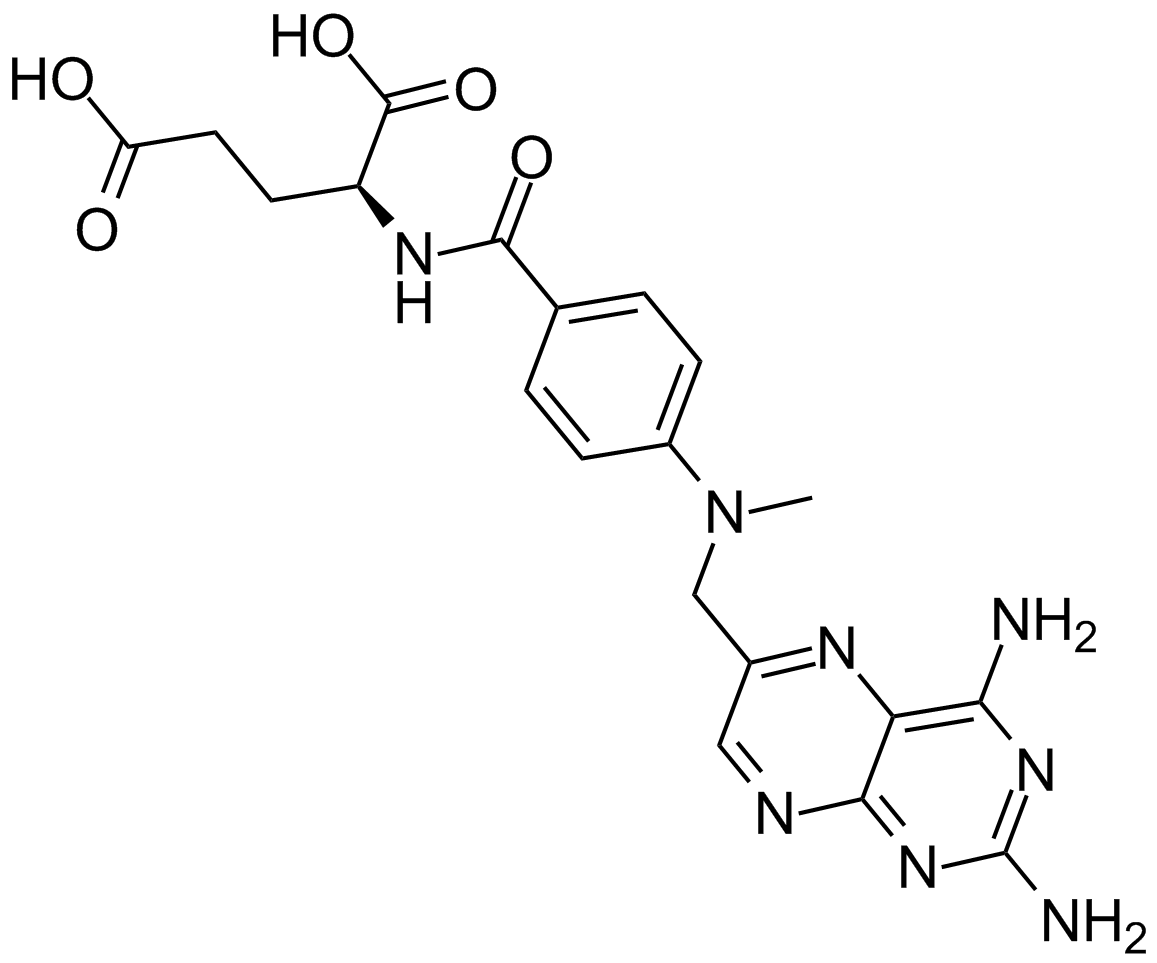
-
GC61047
Methotrexate disodium
Methotrexat (Amethopterin) Dinatrium, ein Antimetabolit und Antifolatmittel, hemmt das Enzym Dihydrofolatreduktase und verhindert dadurch die Umwandlung von FolsÄure in Tetrahydrofolat und hemmt die DNA-Synthese.
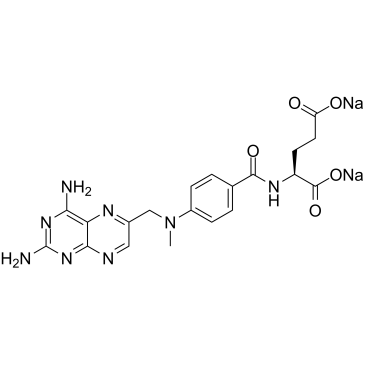
-
GC15798
MMAD
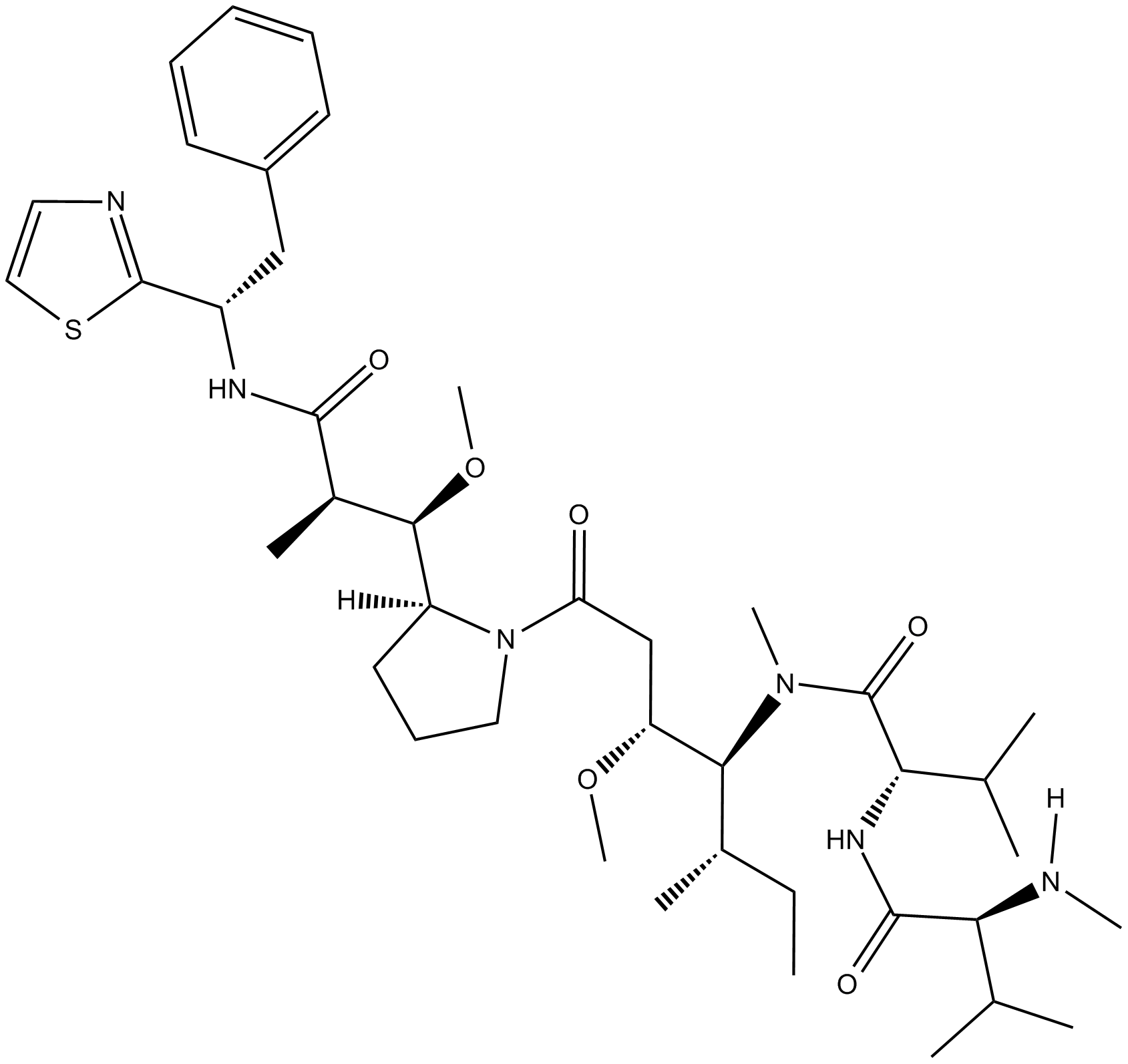
-
GC63775
MMAD-d8
D8-MMAD ist eine deuterierte Form von MMAD, einem Wirkstoff, der die Mikrotubuli zerstÖrt.
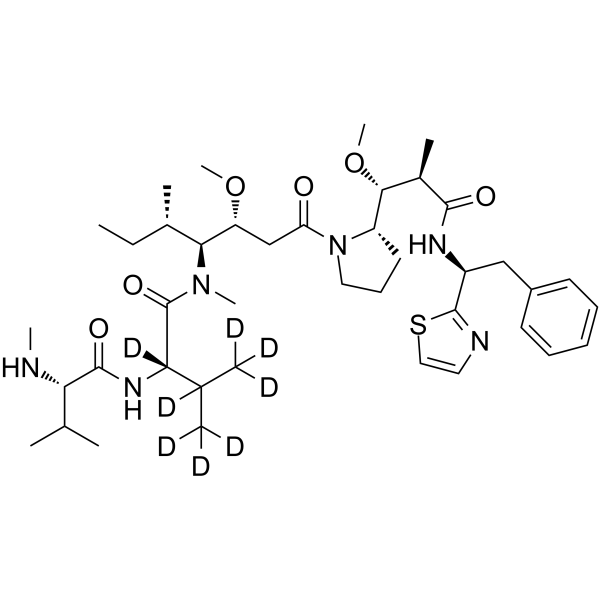
-
GC10034
MMAF
MMAF (Monomethylauristatin F) ist ein potenter Tubulin-Polymerisationsinhibitor und wird als Antitumormittel verwendet. MMAF (Monomethylauristatin F) wird hÄufig als zytotoxische Komponente von AntikÖrper-Wirkstoff-Konjugaten (ADCs) wie Vorsetuzumab Mafodotin und SGN-CD19A verwendet.
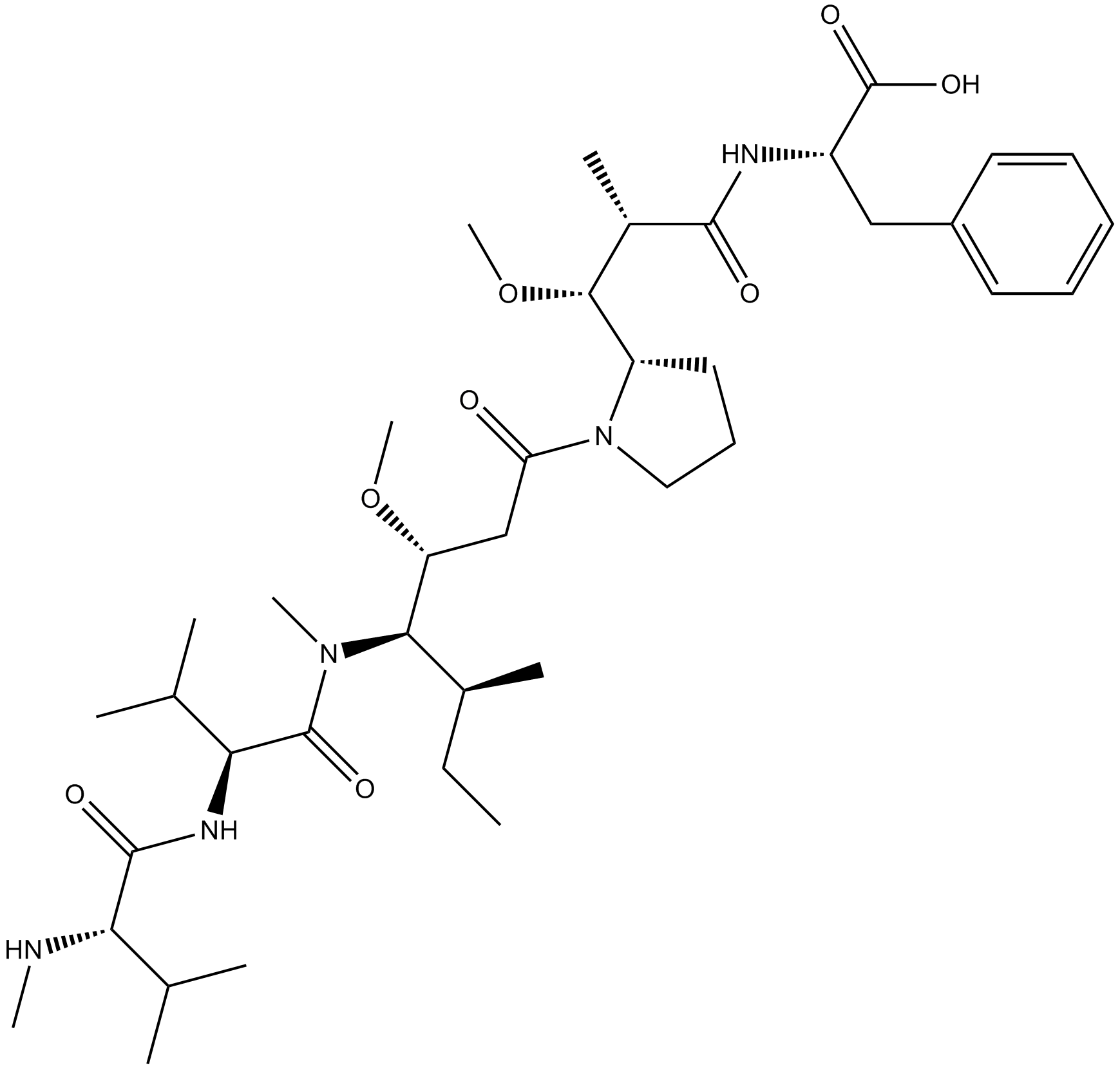
-
GC36633
MMAF Hydrochloride
MMAF (Monomethylauristatin F)-Hydrochlorid ist ein potenter Tubulin-Polymerisationsinhibitor und wird als Antitumormittel verwendet. MMAF-Hydrochlorid wird hÄufig als zytotoxische Komponente von AntikÖrper-Wirkstoff-Konjugaten (ADCs) wie Vorsetuzumab-Mafodotin und SGN-CD19A verwendet.
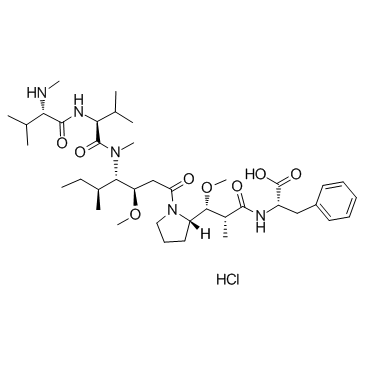
-
GC38397
MMAF sodium
MMAF-Natrium (Monomethylauristatin F-Natrium) ist ein potenter Tubulin-Polymerisationsinhibitor und wird als Antitumormittel verwendet. MMAF-Natrium (Monomethylauristatin-F-Natrium) wird hÄufig als zytotoxische Komponente von AntikÖrper-Wirkstoff-Konjugaten (ADCs) wie Vorsetuzumab-Mafodotin und SGN-CD19A verwendet.
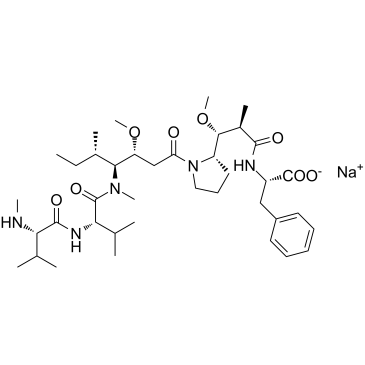
-
GC36634
MMAF-OMe
MMAF-Ome, ein Antitubulinmittel, ist ebenfalls ein ADC-Zytotoxin. MMAF-Ome hemmt mehrere Tumorzelllinien mit IC50-Werten von 0,056 nM, 0,166 nM, 0,183 nM und 0,449 nM fÜr die Zelllinien MDAMB435/5T4, MDAMB361DYT2, MDAMB468 bzw. Raji (5T4-).
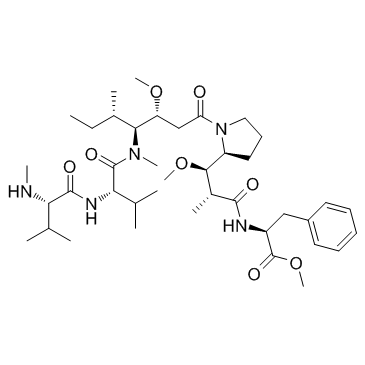
-
GC17276
Monomethyl auristatin E
Ein wirksames antimitotisches Mittel
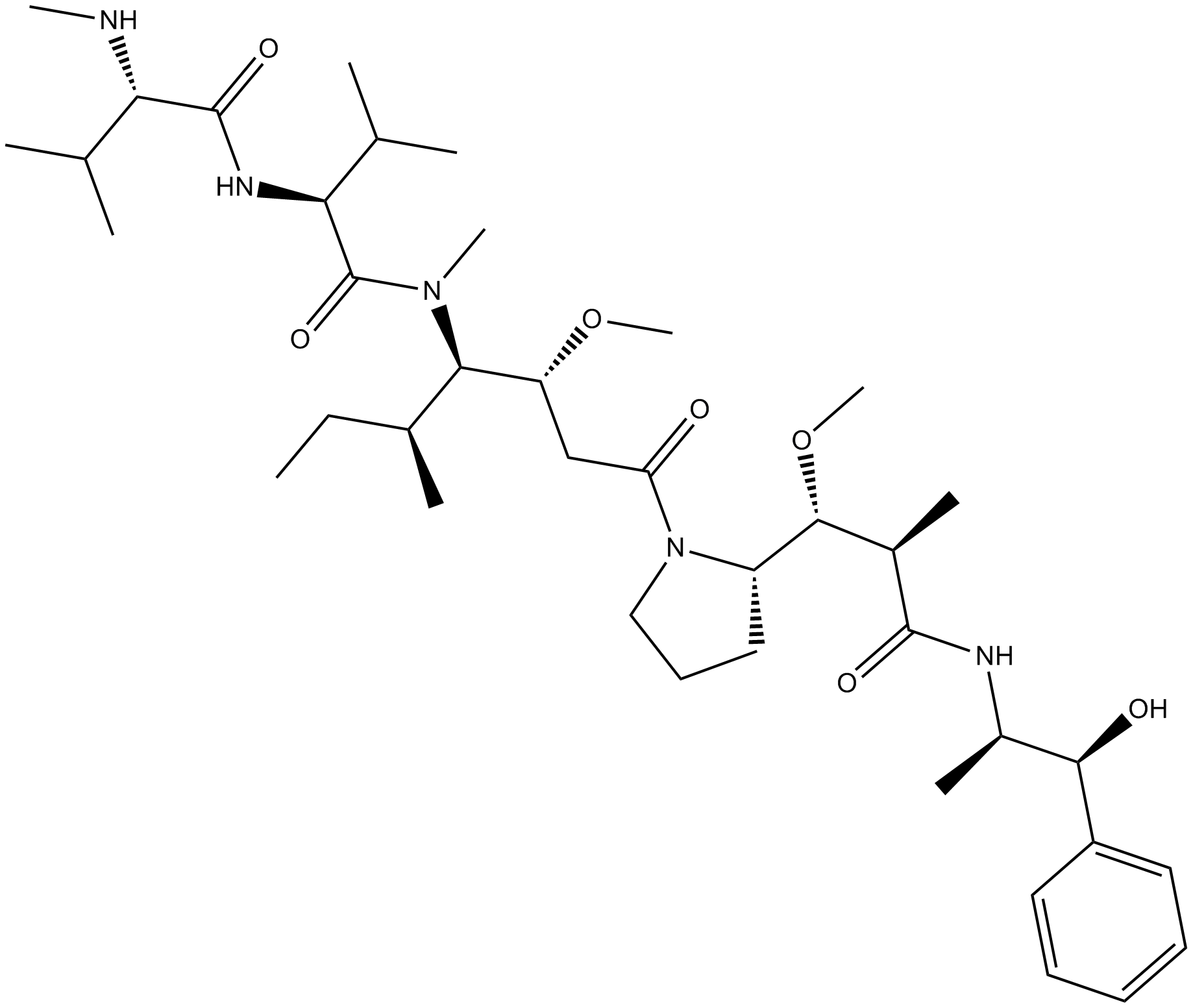
-
GC12511
Paclitaxel (Taxol)
A potent mitotic inhibitor
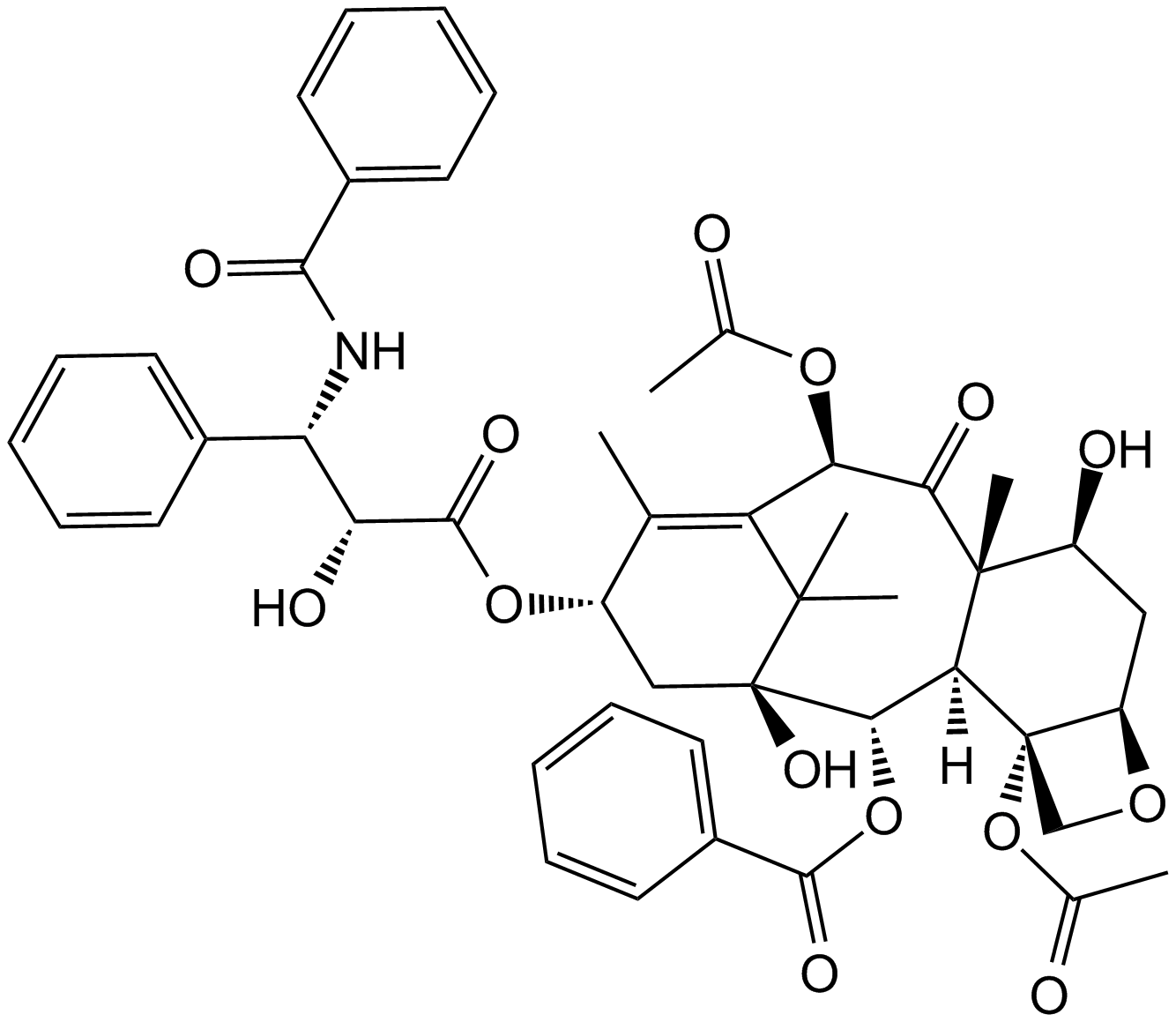
-
GC33136
PF-06380101
PF-06380101 (Aur0101), ein Auristatin-Mikrotubuli-Inhibitor, ist ein zytotoxisches Dolastatin-10-Analogon. PF-06380101 (Aur0101) zeigt im Vergleich zu anderen synthetischen Auristatin-Analoga, die bei der Herstellung von ADCs verwendet werden, hervorragende Potenzen in Tumorzellproliferationsassays und unterschiedliche ADME-Eigenschaften.
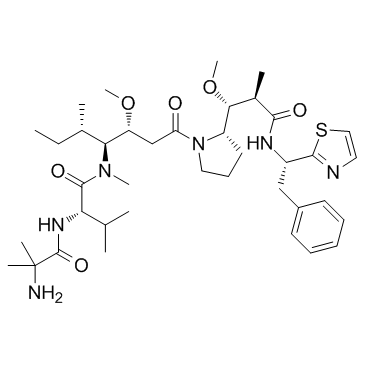
-
GC36941
PNU-159682
PNU-159682, ein Metabolit des Anthracyclins Nemorubicin, ist ein hochpotenter DNA-Topoisomerase-II-Inhibitor mit ausgezeichneter ZytotoxizitÄt. PNU-159682 wirkt als wirksameres und vertrÄglicheres ADC-Zytotoxin als Doxorubicin fÜr die ADC-Synthese. PNU-159682 kann in der EDV-Nanozellentechnologie zur Überwindung von Arzneimittelresistenzen verwendet werden.
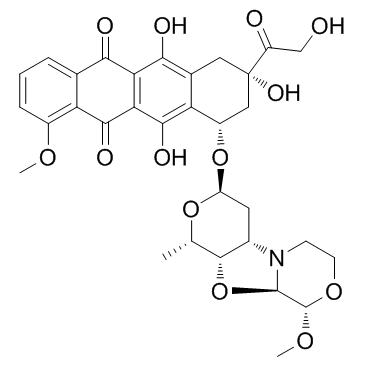
-
GC66071
PNU-159682 carboxylic acid
PNU-159682-CarbonsÄure (Verbindung 53) ist ein potentes ADCs-Cytotoxin und kodiert fÜr ein Mitglied der C-Typ-Lektin/C-Typ-Lektin-Ähnlichen DomÄne (CTL/CTLD)-Superfamilie. PNU-159682-CarbonsÄure hat eine Proteinfaltung und verschiedene Funktionen, wie z. B. ZelladhÄsion, Zell-Zell-SignalÜbertragung, Glykoproteinumsatz und Rollen bei EntzÜndungen und Immunantworten.
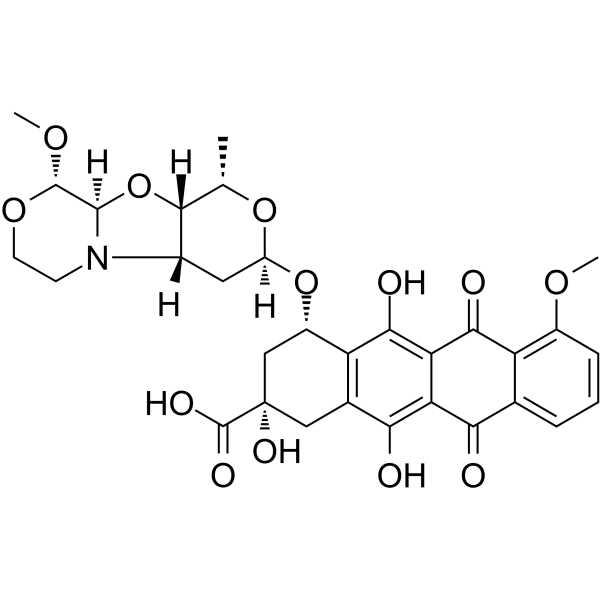
-
GC61213
PROTAC BRD4 Degrader-5-CO-PEG3-N3
PROTAC BRD4 Degrader-5-CO-PEG3-N3 (Compound 2) ist ein PROTAC-Linker-Konjugat fÜr PAC, bestehend aus dem BRD4-Degrader GNE-987 und einem PEG-basierten Linker.
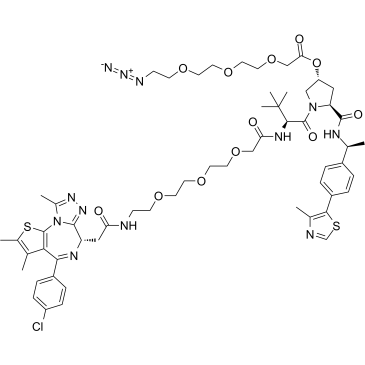
-
GC44809
Rebeccamycin
Rebeccamycin, ein Antitumor-Antibiotikum, hemmt DNA-Topoisomerase I. Rebeccamycin scheint seine primÄre antineoplastische Wirkung durch Vergiftung von Topoisomerase I auszuÜben und hat eine vernachlÄssigbare Wirkung auf Proteinkinase C und Topoisomerase II.

-
GC69863
SC209
SC209 is an ADC cytotoxin derived from patent WO2021247798, used for synthesizing anti-EGFR antibody-active molecule conjugated ADCs. SC209 is a metabolite of STRO-002.
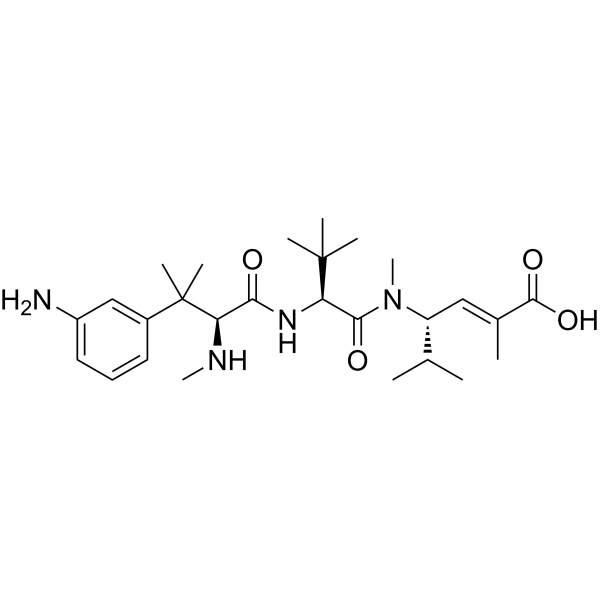
-
GC63184
Seco-DUBA
Seco-DUBA ist ein Duocarmycin (DUBA)-Prodrug mit zwei Hydroxylgruppen, die jeweils Über einen Linker zur Kopplung an einen AntikÖrper genutzt werden kÖnnen.
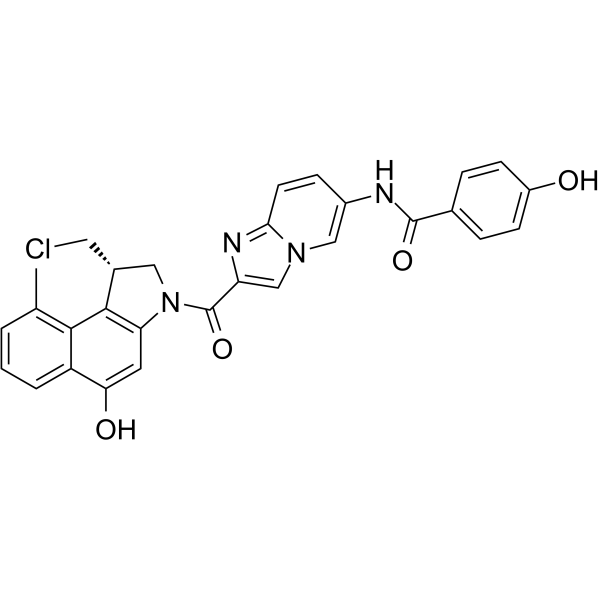
-
GC38349
Seco-Duocarmycin SA
Seco-Duocarmycin SA ist ein DNA-Alkylator und wird als ADC-Zytotoxin verwendet.
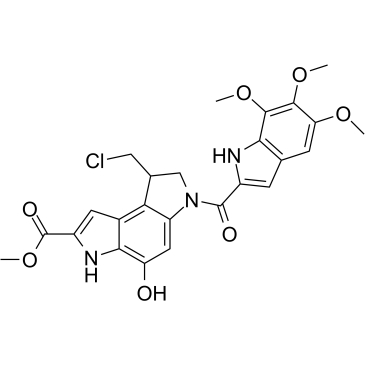
-
GC38354
Seco-Duocarmycin TM
Seco-Duocarmycin TM ist ein DNA-Alkylierungsmittel, das zur Familie der Duocarmycine gehÖrt und die DNA-Synthese hemmt. Seco-Duocarmycin TM ist ein zytotoxischer Wirkstoff, der als zytotoxische Komponente in AntikÖrper-Wirkstoff-Konjugaten (ADC) verwendet wird.
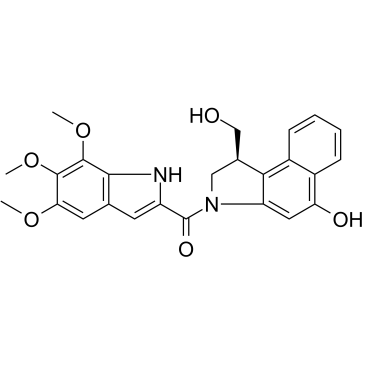
-
GC62691
SG3199
SG3199 ist ein zytotoxisches DNA-Minor-Groove-Interstrand-Crosslinking-Pyrrolobenzodiazepin (PBD)-Dimer. SG3199 ist die freigesetzte Kriegskopfkomponente der ADC-Nutzlast Tesirine (SG3249).
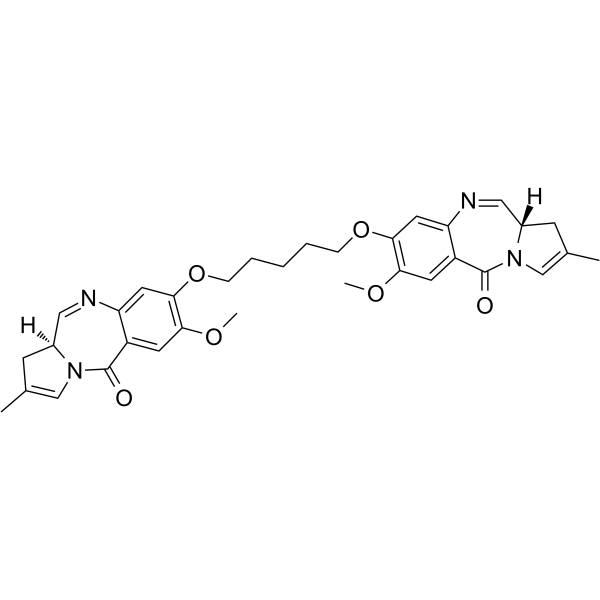
-
GC63189
SGD-1882
SGD-1882 ist ein zytotoxisches Pyrrolobenzodiazepin (PBD)-Dimer, das als Vernetzungsmittel fÜr die kleine DNA-Nut dient und als Payload fÜr ADCs dient.
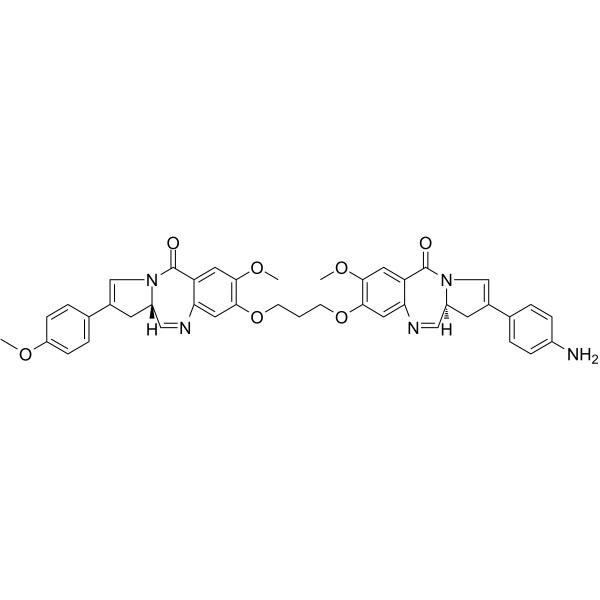
-
GC34086
SJG-136 (NSC-694501)
SJG-136 (NSC-694501) ist ein DNA-Vernetzungsmittel mit einem XL50 von 45 nM fÜr pBR322-DNA. SJG-136 (NSC-694501) hat eine starke AntitumoraktivitÄt.
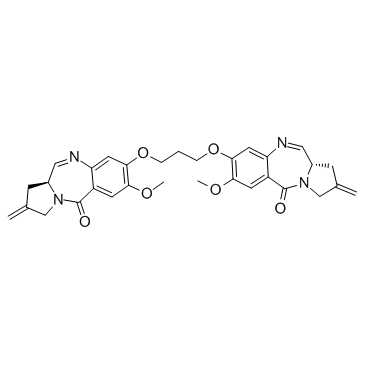
-
GN10449
SN-38 (NK012)
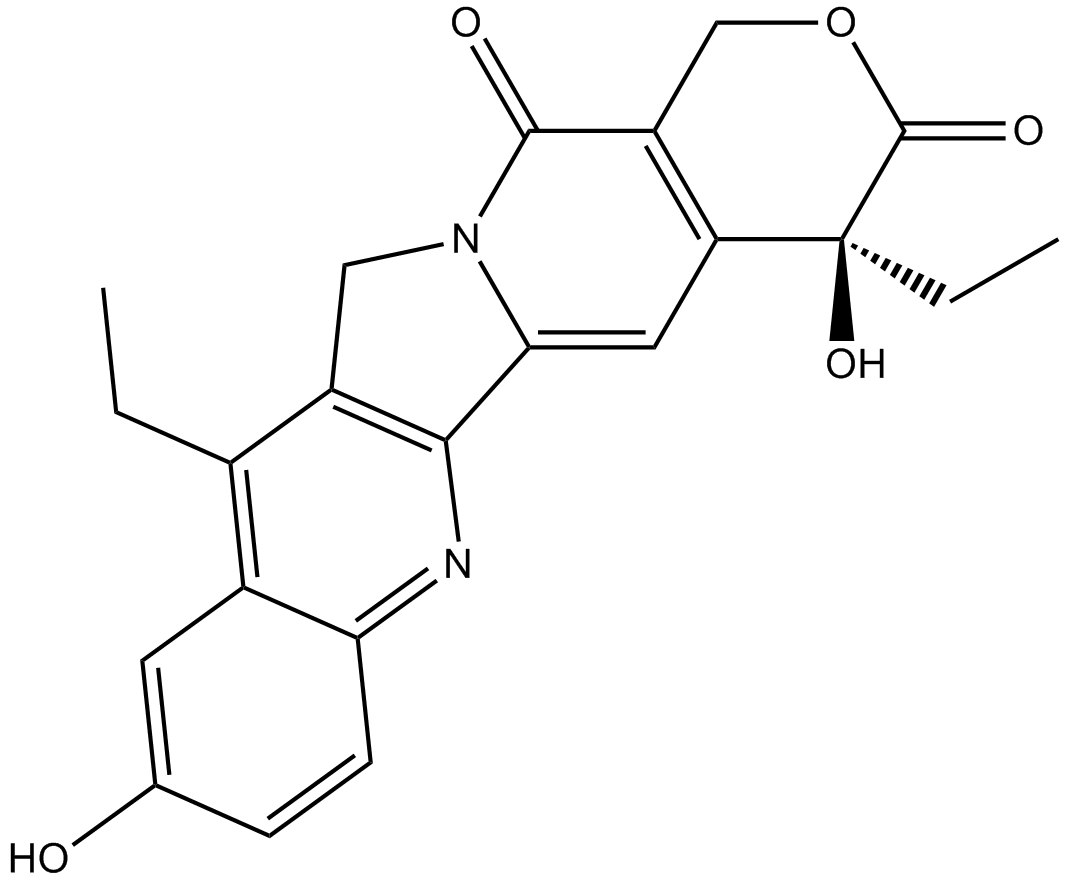
-
GC32753
Taltobulin (HTI-286)
Taltobulin (HTI-286) (HTI-286), ein synthetisches Analogon des Tripeptids Hemiasterlin, ist ein wirksames Antimikrotubuli-Mittel, das die P-Glykoprotein-vermittelte Resistenz in vitro und in vivo umgeht. Taltobulin (HTI-286) hemmt die Polymerisation von gereinigtem Tubulin, unterbricht die Organisation der Mikrotubuli in Zellen und induziert einen mitotischen Stillstand sowie Apoptose.
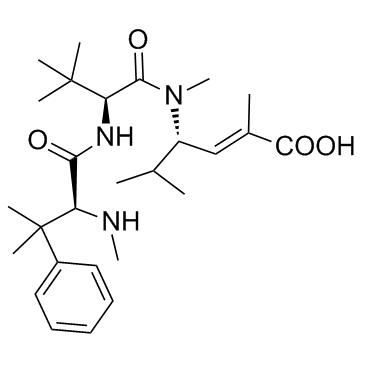
-
GC61314
Taltobulin hydrochloride
Taltobulin-Hydrochlorid (HTI-286-Hydrochlorid), ein synthetisches Analogon des Tripeptids Hemiasterlin, ist ein wirksames Antimikrotubuli-Mittel, das die P-Glykoprotein-vermittelte Resistenz in vitro und in vivo umgeht. Taltobulinhydrochlorid hemmt die Polymerisation von gereinigtem Tubulin, unterbricht die Organisation der Mikrotubuli in Zellen und induziert einen mitotischen Arrest sowie Apoptose.
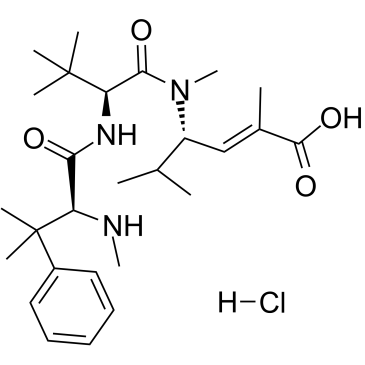
-
GC34303
Taltobulin hydrochloride (HTI-286 hydrochloride)
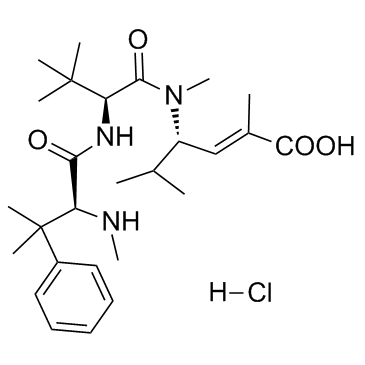
-
GC34135
Taltobulin trifluoroacetate (HTI-286 trifluoroacetate)
Taltobulin-Trifluoracetat (HTI-286-Trifluoracetat) (HTI-286-Trifluoracetat), ein synthetisches Analogon des Tripeptids Hemiasterlin, ist ein wirksames Antimikrotubuli-Mittel, das die P-Glykoprotein-vermittelte Resistenz in vitro und in vivo umgeht. Taltobulintrifluoracetat (HTI-286-Trifluoracetat) hemmt die Polymerisation von gereinigtem Tubulin, unterbricht die Organisation der Mikrotubuli in Zellen und induziert einen mitotischen Stillstand sowie Apoptose.
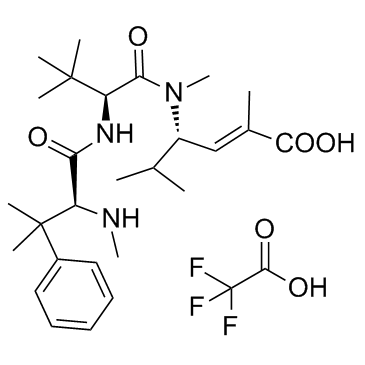
-
GC62288
Thailanstatin A
Thailanstatin A ist ein ultrapotenter Inhibitor des eukaryotischen RNA-Spleißens (IC50=650 nM). Thailanstatin A Übt Wirkungen Über eine nicht-kovalente Bindung an die SF3b-Untereinheit des U2-snRNA-Subkomplexes des Spleißosoms aus und zeigt IC50-Werte von niedrigen nM bis sub-nM gegen mehrere Krebszelllinien. Thailanstatin A, eine Nutzlast fÜr ADCs, wird an die Lysine auf Trastuzumab konjugiert, wodurch ein „linkerloses" ADC entsteht.
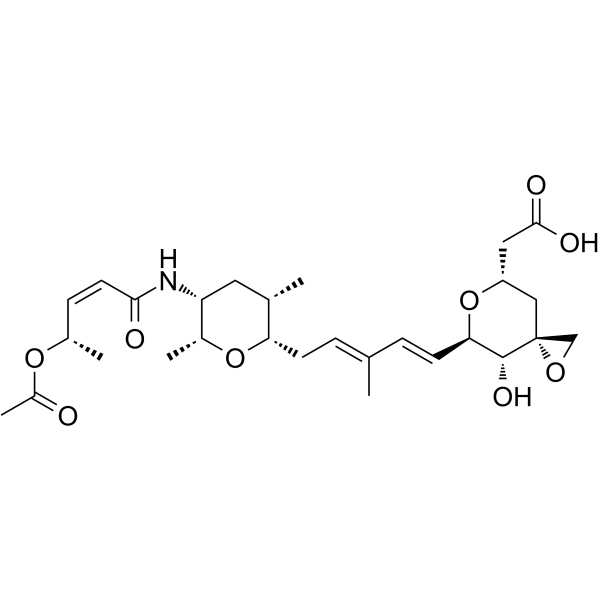
-
GC70043
Tomaymycin DM
Tomaymycin DM is a DNA-alkylating agent, which is a derivative of Tomaymycin and a monomer of PBD. It can serve as an effective payload for tumor-targeting antibody-drug conjugates (ADCs).
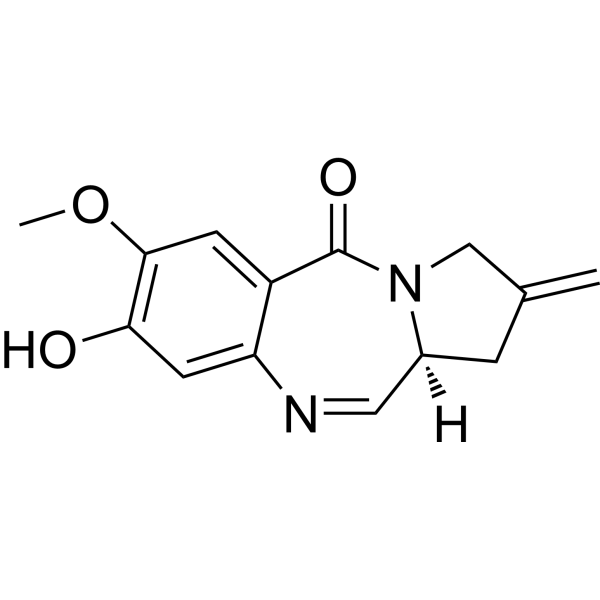
-
GC33155
Tubulysin A (TubA)
Tubulysin A (TubA)(TubA) ist ein myxobakterielles Produkt, das in vielen In-vitro-Assays als antiangiogenes Mittel fungieren kann; anti-mikrotubuli, anti-mitotisch, ein Apoptose-Induktor, Anti-Krebs, anti-angiogen und antiproliferativ.
